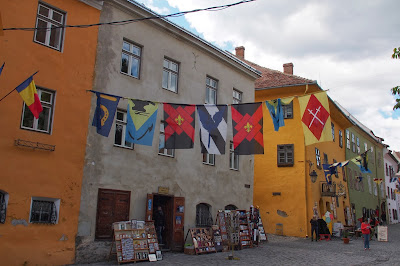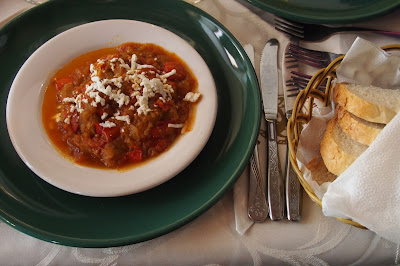We passed through some fields
Everywhere we passed, we saw orthodox churches
the houses of peasants
Some bigger than others
Some more colorful than others

The fortress is built on a hill on the borders between Transylvania and Wallachia. Count Dracula is in fact the name of principal character in Irish writer Bram Stoker's horror novel published in 1897. Stoker’s Count Dracula is a centuries-old vampire, sorcerer, and Transylvanian nobleman, who claims to be a Székely descended from Attila the Hun. He inhabits a decaying castle in the Carpathian Mountains. In his conversations with the character Jonathan Harker, Dracula reveals himself as intensely proud of his boyar culture with a yearning for memories of his past. Dracula appears to have studied the black arts at the Academy of Scholomance in the Carpathian Mountains, near the town of Sibiu (then known as Hermannstadt). While Stoker named his Transylvanian Count “Dracula”, he was careful not to suggest an actual link to the historical character of Vlad Tepes. While Stoker’s character Van Helsing muses as to whether Count Dracula might be the Voivode Dracula, he obviously is not since Count Dracula of Transylvania is plainly not the Wallachian Prince Vlad Tepes (Vlad the Impaler) (1448-1476) and Stoker was disinclined at all to make his character a real person of historic significance.
But the name “Dracula”, far from being a frightening term, in fact derives from the Crusader Order of the Dragon with which Order both Vlad Tepes,and his father had been associated.Stoker himself never visited the castle or hardly knew anything about it. It's believed that when he was writing the novel, what he had in mind was the bare mountain top of the 2033 meter high Mount Izvorul Călimanului in the Transylvanian Kelemen Alps near the former border with Moldavia. Researchers think that Stoker probably used the illustration of Bran Castle in Charles Boner’s book, "Transylvania: Its Product and Its People", (London: Longmans, 1865) to describe his imaginary Dracula's Castle. But because Bran Castle is the only castle in all of Transylvania that actually fits Bram Stoker’s description of Dracula’s Castle, it is now known throughout the world as Dracula’s Castle
Vlad Tepes (Vlad the Impaler) is believed to be a blood thirsty ruler. One explanation of why he is thought to be a vampire is that he was suffering from a rare disease which requires the consumption of blood for its cure. Another is that he was thought to be a blood-thirsty ruler in the way he treated his enemies. A third theory is that in the villages near Bran, there is a belief in the existence of evil spirits called ghosts or “steregoi” (a variant of “strigoi”). Until half a century ago, it was believed that there existed certain living people – “strigoi” – who were leading a normal life during the day but at night, during their sleep, their souls left their bodies and haunted the village tormenting people in their sleep. These evil spirits haunt their prey from midnight until the first cockcrow, when their power to harm people faded. “The undead [i.e., ghosts, vampires] suffer from the curse of immortality,” writes Stoker, “they pass from one period to another, multiplying their victims, augmenting the evil in the world…” The Dracula character derives from these local myths.
In fact, Vlad's actual connection with Bran Castle was very tenuous. He was involved in several campaigns to punish the German merchants of Brasov who failed to abide by his commands as regards their trade in his Walachian markets. Passage to Wallachia was through Bran, the closest gorge to Brasov, which connects with Targoviste, Vlad Tepes’ capital. The original customs houses at which taxes were collected from merchants entering Transylvania are still at the base of Bran Castle. The relationships with the Bran lords were not very cordial, as they were representatives of the Citadel of Brasov, which were hostile to Vlad the Impaler. It is not known if Vlad Tepes captured Bran Castle. Written documents do not describe it. The documents that do exist in archives with regard to Bran Castle, are mainly administrative and refer to the income and expenditure of the domain of the Bran Fortress, with little mention of political and military events. However, historians found that in the fall of 1462, after the army of the Hungarian king, Matei Corvin, captured Vlad Tepes nearby the fortress of Podul Dambovitei, near Rucar, Vlad was taken to Bran Castle and locked up there for two months. This is affirmed in the recent volume Vlad The Impaler – Dracula, published by the Mirador Printing House, Arad, 2002, written by Gheorghe Lazea Postelnicu. From here, Vlad was taken and imprisoned in the Visegrad Fortress.
The castle is now a museum open to tourists, displaying art and furniture collected by Queen Marie. At the bottom of the hill is a small open air museum park exhibiting traditional Romanian peasant structures (cottages, barns, etc.) from across the country.
As a matter of history, not of legend, there was a wooden castle called Dietrichstein in the Burzenland in 1212 at the entrance to a much frequented trade route defended by the Teutonic knights but it was destroyed in 1242 by the Mongols. In 1377, permission was given by King Louis I of Hungary to the Saxons of Kronstadt (Brazov today) to build a stone castle at their own expense and the same was used to resist Turkish invasion 1438-1442. It was later used a customs post between Transylvania and Wallachia. Because the Magyar King Vladislas II’s failed to repay loans, the city of Brasov took possession of the fortress in 1533. As Bran Castle occupied a strategic position in the trade route, it has militarily important up to the mid-18th century.
Two years after Translyvania became part of the Greater Romania, the citizens of Brazov decided to offer it as a gift to Queen Marie in 1920 and after renovating it, it became her favorite residence. She passed it to her daughter Princess Ileana but when the Communists took over control of Romania, it expelled the royal family in 1948. However, in 2005, the Romanian government passed a special law allowing restitution claims on properties illegally expropriated, such as Bran, and thus a year later the castle was given back to Dominic von Habsburg, the son and heir of Princess Ileana, a decision which the Constitutional Court of Romania affirmed in December 2007 despite the challenge to the claim by the Romanian Parliament. On May 18, 2009, the Bran Castle administration was transferred from the government to the administration of Archduke Dominic and his sisters Maria-Magdalena Holzhausen and Elisabet Sandhofer. On June 1 the same year the Habsburgs opened the refurbished castle to the public as the first private museum of the country to help boost its tourist industry.
The road at the side of the Castle entrance
the road leading up to the castle
The path up was lined with flags
A line of flags in all colors
A panoramic view of the Castle square
A Romanian dressed in old fashioned clothes
a closer view of the castle square
Our first view of the famous clock tower
A closer view of the clock tower
The entrance to our restaurant
Various Dracula products for sale at the entrance to our Dracula restaurant
The hall on the first floor of the Dracula Restaurant
the staircase
A painting of the Bran Castle
A wall decoration
Various axes, hatchets, knives, swords etc
Various souvenirs
the Reception Counter
Our dining room
Another one
Wall decoration
the drummer
Our soup
Our main course
Our dessert
Another restaurant
Sandwiches for sale
A souvenir shop
A church inside the castle
A museum of medieval arms in the history of Sighisoara
The entrance to the museum
a close up of the tower clock
The square to the left of the entrance
A guard tower
The way up the guard tower
The way up the Castle Cathedral
a musician in need of money
At the very top of the hill, is the Castle Cathedral. There is an attic there where each important family can have a chest of ham placed because it is high and dry there and only the person who is head of the family can hold the key!
One of its windows
The museum of Translyvanian peasantry
The Dracula Terrace
A girl selling some handicraft
A Lutheran Mission House
The garage
flowers under a window, a widespread Balkans practice
Masks for sale
More masks for sale
Metal windows
an ancient tower house
A well planted garden in front
to one side of the house, we got a good view of the city and river below
There were lots and lots of clouds
another side of the valley
A panorama view of the city of Sighisoara
The towers of churches below
I went up the clock tower: these are the figures who would strike the hour each hour
all kinds of clocks there
Old fashioned printing press
Molds for woodblocks printing
Various table ware
Primitive clock? Although there are words, I don't know a word of it.
Various table wares
More clocks etc
a grain press?
Old fashioned chess for storing ham
A model of the castle
Another square inside the castle
After the visit to the Bran Castle, we were on our way again, passing through miles and miles of fields like these
The hay is all bundled up into rolls
as everywhere on the Balkans, maize is an important crop and I began to have an idea why all the countries to its north wanted to fight over the Balkans
clouds above clumps of trees on the small hillocks
The country is rich
How green they look
The fields are separated by rows of hedges
From time to time we passed through fortifications like this
There seem to be unlimited land for grazing
The sun was setting

It was sinking behind the trees

It was sinking behind the trees
it was getting darker and darker
It has sunk beneath the horizon
Time for a rest break





















































































沒有留言:
張貼留言